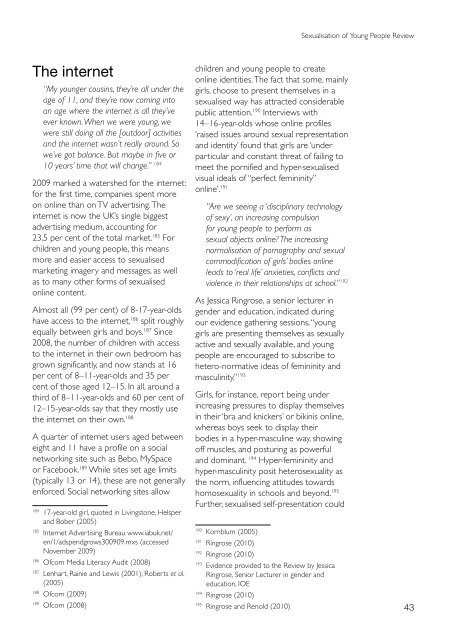Sexualistation of Young People
Sexualistation of Young People
Sexualistation of Young People
You also want an ePaper? Increase the reach of your titles
YUMPU automatically turns print PDFs into web optimized ePapers that Google loves.
The internet<br />
“My younger cousins, they’re all under the<br />
age <strong>of</strong> 11, and they’re now coming into<br />
an age where the internet is all they’ve<br />
ever known. When we were young, we<br />
were still doing all the [outdoor] activities<br />
and the internet wasn’t really around. So<br />
we’ve got balance. But maybe in five or<br />
10 years’ time that will change.” 184<br />
2009 marked a watershed for the internet:<br />
for the first time, companies spent more<br />
on online than on TV advertising. The<br />
internet is now the UK’s single biggest<br />
advertising medium, accounting for<br />
23.5 per cent <strong>of</strong> the total market. 185 For<br />
children and young people, this means<br />
more and easier access to sexualised<br />
marketing imagery and messages, as well<br />
as to many other forms <strong>of</strong> sexualised<br />
online content.<br />
Almost all (99 per cent) <strong>of</strong> 8-17-year-olds<br />
have access to the internet, 186 split roughly<br />
equally between girls and boys. 187 Since<br />
2008, the number <strong>of</strong> children with access<br />
to the internet in their own bedroom has<br />
grown significantly, and now stands at 16<br />
per cent <strong>of</strong> 8–11-year-olds and 35 per<br />
cent <strong>of</strong> those aged 12–15. In all, around a<br />
third <strong>of</strong> 8–11-year-olds and 60 per cent <strong>of</strong><br />
12–15-year-olds say that they mostly use<br />
the internet on their own. 188<br />
A quarter <strong>of</strong> internet users aged between<br />
eight and 11 have a pr<strong>of</strong>ile on a social<br />
networking site such as Bebo, MySpace<br />
or Facebook. 189 While sites set age limits<br />
(typically 13 or 14), these are not generally<br />
enforced. Social networking sites allow<br />
184 17-year-old girl, quoted in Livingstone, Helsper<br />
and Bober (2005)<br />
185 Internet Advertising Bureau www.iabuk.net/<br />
en/1/adspendgrows300909.mxs (accessed<br />
November 2009)<br />
186 Ofcom Media Literacy Audit (2008)<br />
187 Lenhart, Rainie and Lewis (2001); Roberts et al.<br />
(2005)<br />
188 Ofcom (2009)<br />
189 Ofcom (2008)<br />
children and young people to create<br />
online identities. The fact that some, mainly<br />
girls, choose to present themselves in a<br />
sexualised way has attracted considerable<br />
public attention. 190 Interviews with<br />
14–16-year-olds whose online pr<strong>of</strong>iles<br />
‘raised issues around sexual representation<br />
and identity’ found that girls are ‘under<br />
particular and constant threat <strong>of</strong> failing to<br />
meet the pornified and hyper-sexualised<br />
visual ideals <strong>of</strong> “perfect femininity”<br />
online’. 191<br />
“Are we seeing a ‘disciplinary technology<br />
<strong>of</strong> sexy’, an increasing compulsion<br />
for young people to perform as<br />
sexual objects online? The increasing<br />
normalisation <strong>of</strong> pornography and sexual<br />
commodification <strong>of</strong> girls’ bodies online<br />
leads to ‘real life’ anxieties, conflicts and<br />
violence in their relationships at school.” 192<br />
As Jessica Ringrose, a senior lecturer in<br />
gender and education, indicated during<br />
our evidence gathering sessions, “young<br />
girls are presenting themselves as sexually<br />
active and sexually available, and young<br />
people are encouraged to subscribe to<br />
hetero-normative ideas <strong>of</strong> femininity and<br />
masculinity.” 193<br />
Girls, for instance, report being under<br />
increasing pressures to display themselves<br />
in their ‘bra and knickers’ or bikinis online,<br />
whereas boys seek to display their<br />
bodies in a hyper-masculine way, showing<br />
<strong>of</strong>f muscles, and posturing as powerful<br />
and dominant. 194 Hyper-femininity and<br />
hyper-masculinity posit heterosexuality as<br />
the norm, influencing attitudes towards<br />
homosexuality in schools and beyond. 195<br />
Further, sexualised self-presentation could<br />
190 Kornblum (2005)<br />
191 Ringrose (2010)<br />
192 Ringrose (2010)<br />
193 Evidence provided to the Review by Jessica<br />
Ringrose, Senior Lecturer in gender and<br />
education, IOE<br />
194 Ringrose (2010)<br />
195 Ringrose and Renold (2010)<br />
Sexualisation <strong>of</strong> <strong>Young</strong> <strong>People</strong> Review<br />
43

















